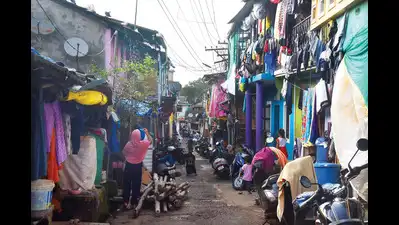ARTICLE AD BOX

CALM DESPITE THE CHAOS: Indiranagar's inhabitants survive in sub-par conditions in an area plagued by garbage mismanagement
Tucked along the outskirts of Panaji, Chimbel’s Indiranagar slum carries a history that stretches back to the 1970s. It began with a promise of housing for the city’s labour force but has today grown into a dense, self-contained settlement

Four years ago, when former India captain Rahul Dravid lost his cool and waved his bat threateningly, shouting “Indira Nagar ka gunda hoon main,” everyone was stunned. Thankfully, Dravid’s antics were only for an advertisement as he referenced the locality in Bengaluru.Here in Goa, if someone shouts the same words as Dravid, not many eyebrows will be raised.Indiranagar, a huge slum in Chimbel, on the outskirts of Goa’s capital, has been often described by local police as a “hideout for anti-social elements”. Before every poll, it’s customary for the election authorities to tag the area as ‘most vulnerable’ or ‘hypersensitive’.

Indiranagar has lived with the anti-social tag for far too long but has so much to offer.
Chimbel hosts five schools, ensuring most underprivileged children have access to education, while several from the younger generation have graduated, some even completing degrees in law and engineering.Securing jobs though isn’t always easy.“Many graduates work as drivers, sales assistants, or remain at home, unable to find jobs that match their qualifications,” Babajan Nelgi, a senior citizen, said. “My own granddaughter is at home, despite her degree.”
It was in 1973, under Prime Minister Indira Gandhi’s 20-Point Programme, that 360 beneficiaries—mostly labourers from ghettos at Altinho—were allotted homes in Chimbel. Named Indiranagar, this settlement soon became home to migrant families, largely from Tamil Nadu, Andhra Pradesh and Karnataka.By the late 1980s and early 1990s, Indiranagar transformed into a haven for unskilled workers and migrants.“With support from the panchayat, homes were provided house numbers, and the MLA at the time (Victor Gonsalves) helped connect the settlement to water supply,” said social worker, Iqbal Shaikh.

Gonsalves also helped with a water tank which enabled house-to-house water connection. Electricity connection and tarred roads followed.Over the decades, the neighbourhood swelled. From the original 360 houses, the count has gone up to nearly 3,500, besides around 100 shanties, approximately 5,500 registered voters, and over 1,000 children.With such numbers, Indiranagar has a major say on who makes it to the state assembly from Santa Cruz.
For any candidate to emerge triumphant, it is important to capture Chimbel, particularly Indiranagar, which consists more than half of the over 10,500 votes in the village. No wonder candidates and national party leaders camp here, stage corner meetings, and hold door-to-door campaigns where money, and gift coupons, are often slipped into the hands of voters.“A classic tale of vote bank politics,” said Shaikh.Despite attempts by anti-social elements to create a religious divide, locals say, the sense of community remains strong.The area is free of widespread sanitation issues, while almost every household has a toilet, access to electricity, and running water

From the original 360 houses, the count has gone up to nearly 3,500, besides around 100 shanties, approximately 5,500 registered voters, and over 1,000 children
“It was Congress that built Indiranagar, now it doesn’t matter which party the MLA belongs to. Our civic problems are handled by the sarpanch and social workers, not politicians,” said Noor Ahmed, a rickshaw driver.If there is one major hardship, it’s the absence of proper health facilities. Common illnesses like cold and fever are rampant, yet residents are forced to travel to health centres at Santa Cruz or Bambolim. A handful of local clinics function near the settlement, but with doctors available only for a few hours a day, the services are inadequate for such a large population.For many, survival comes down to the work they can find. Fruit and flower vendors are considered among the more financially secure residents, while those at the bottom of the hierarchy include beggars.
More recently, many of the residents have bought vehicles which they operate as taxis, dominating stands in Panaji, largely outside casinos.Their fight now is to ensure that the next chapter of their story is not just about survival, but about opportunity.“We have survived 50 years in this slum and seen progress move at a snail’s pace. We are optimistic that the way ahead is forward. In a few decades, we will have a dignified story of rags to riches to tell the people of Goa,” said Shaikh.




.png)
.png)
.png)
















 6 days ago
8
6 days ago
8







 English (US) ·
English (US) ·